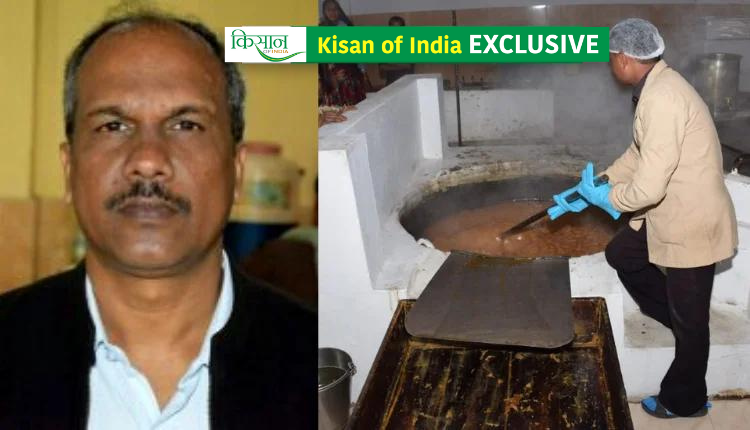Know how you can earn by Modern Jaggery Unit?
Indian Sugarcane Research Institute has created a modern jaggery unit producing 10 quintals of jaggery per day
The method of making jaggery from sugarcane juice has been prevalent in the country for centuries. From an employment point of view, it is a good business for the farmers at the rural level. However, there’s a need to improve the quality of jaggery in a cost-effective manner. In fact, with the development of technology, many such resources and techniques have been developed which can reduce the cost of making jaggery to half and improve its quality. By adopting new techniques and methods for jaggery production, one can earn double the profits by making good quality products at a low cost.

Modern jaggery unit makes 10 quintal jaggery per day
Dr. Dileep Kumar, Principal Scientist of Indian Institute of Sugarcane Research, Lucknow says that if farmers want to make jaggery, then include new technologies in it. With this, both the quantity and quality of jaggery can be increased, which fetches a better price in the market. He said that his institute had developed a modern jaggery unit of three furnaces producing 10 quintal jaggery per day. With this, high-quality jaggery can be made by extracting more juice from solid and clean sugarcane.
The agricultural scientist says that to make a modern jaggery unit, a room of 100 square meters is needed for a furnace and sugarcane crusher. Along with this, 200 square meters of space is required for storing sugarcane or drying bagasse. The first machine in the process of making jaggery is the crusher with which sugarcane juice is extracted.
At the time of harvesting, sugarcane needs to be cleaned thoroughly, especially the roots. It should be crushed within 6 to 12 hours of harvesting. This maintains the quality of sugarcane juice. Along with this, the Brix-reading of sugarcane should be between 20 and 21. This makes it easy to make good-quality jaggery.
15 to 20 kg more sugarcane juice comes out of a modern crusher machine
Dr. Dileep said the modern sugarcane crusher machines are available in the market. As compared to old machines which produced around 45kg of sugarcane juice, the new machine can produce 60 to 65 kg of sugarcane juice from 100 kg of sugarcane. This crusher machine can be easily operated with a 10-horsepower motor. The extracted juice of sugarcane is then boiled and dried.
The three-layer special furnace makes jaggery in less energy and less time. He said while earlier it used to take one and a half to two hours to prepare jaggery, it is now ready in just 45 minutes.

Important tips for the quality, storage, and color of jaggery
Usually, during the boiling of sugarcane juice, many chemicals are added to refine it and improve its color. Dr. Dileep Kumar suggests that instead of chemical purifiers, botanical ones should be used. He recommends using the stem of the wild ladyfinger. In order to remove impurities from 1000 liters of sugarcane juice, 2 kg of bhindi or phalsa juice should be added to it. The impurities that rise to the surface should be removed within 15 minutes of the heating process.
Also Read: Natural farming reduced the cost and increased profit for this farmer of Andhra Pradesh
To bring stiffness to the jaggery, 200 ml castor oil or groundnut oil should be added. When the temperature of the sugarcane juice reaches 97 degrees Celsius, 250 grams of lime juice needs to be added. This process brings down the pH value of jaggery from 6.50 to 5.50. It further improves the color of the jaggery and its shelf-life.
Can earn 35 to 40 lakhs annually
Dr. Dileep Kumar says that the present era is all about value addition, i.e., by adding important ingredients, the farmers can improve the quality of the product manifold. The improved quality can lead to an increase in demand. Thus, farmers can add things like dry ginger, almond, peanut, sesame, linseed, turmeric, ajwain, or amla to the jaggery. With proper training and knowledge, farmers can produce around 200 to 250 kg jaggery.
This can enable farmers to set up a jaggery-producing unit as a business in their village. This type of unit costs around Rs.15 lakhs and 10 quintals of jaggery can be produced per day. If this unit functions for 200 days in a year, then 2000 quintals of jaggery can be made. Thus, farmers can earn around Rs 35 to 40 lakh annually after deducting expenses.
If the farmers want to sell jaggery with branding, then they can get a license from the food department. The product can be marketed and sold in 200 – 500 grams packaging. In this way, the farmers can earn more profit by making good quality jaggery from their own yield. The Indian Sugarcane Research Institute has developed a unit where the farmers can come and learn the technique and method.
Contact details: If farmers want to share information or experiences related to farming with us, then they can do this by calling us on the phone number 9599273766 or by writing an email to [email protected] or by sending your recording. Through Kisan of India, we will convey your message to the people, because we believe that if the farmers are advanced then the country is happy.
You can connect with Kisan of India on Facebook, Twitter, and Whatsapp and Subscribe to our YouTube channel.



